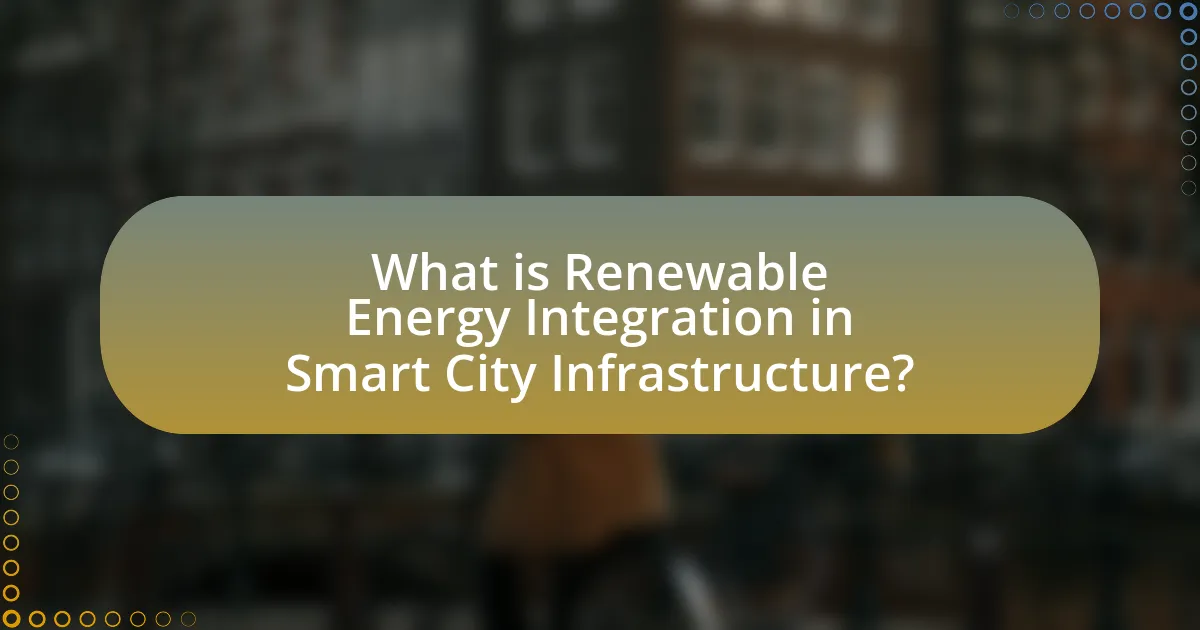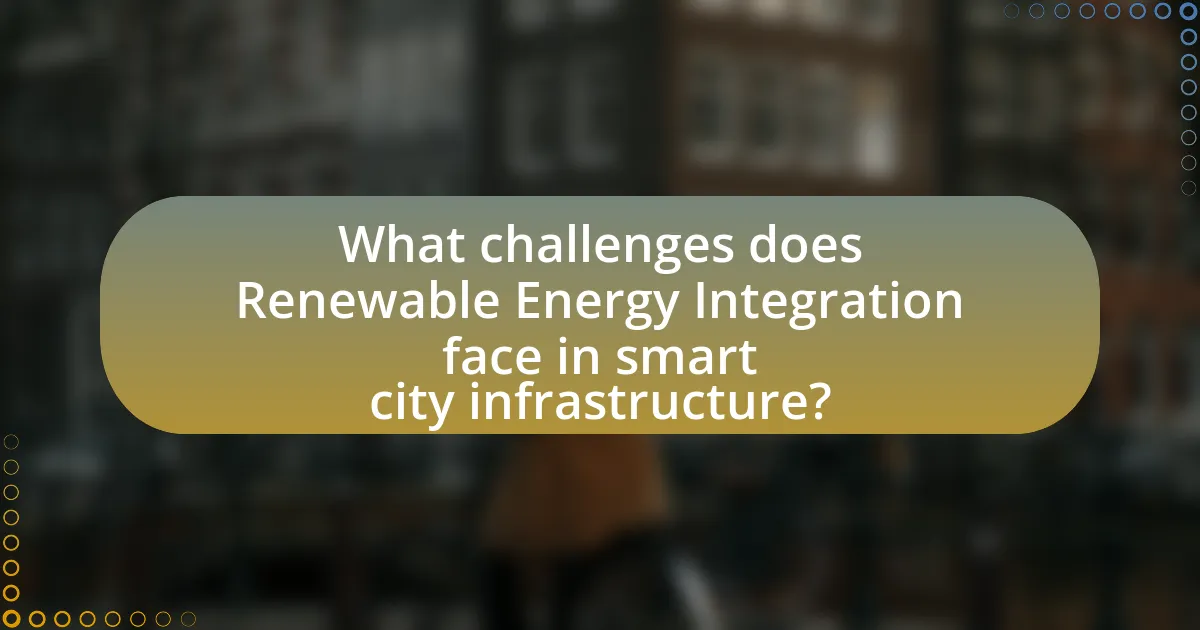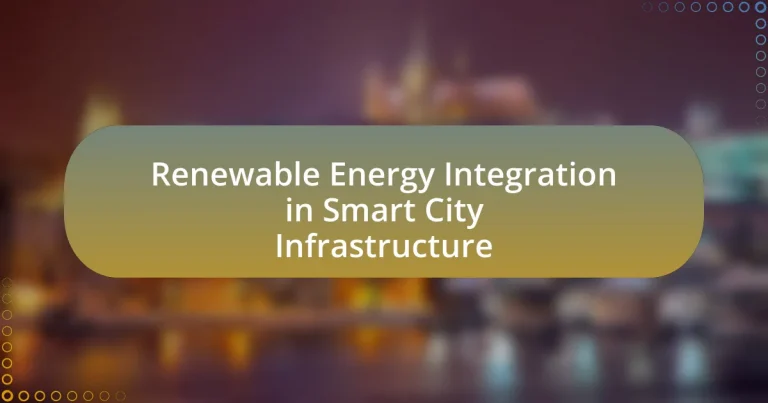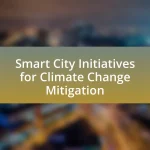Renewable energy integration in smart city infrastructure involves incorporating renewable sources such as solar, wind, and biomass into urban energy systems to enhance sustainability and efficiency. This integration aims to reduce reliance on fossil fuels, lower greenhouse gas emissions, and improve energy resilience, ultimately enhancing urban living conditions. Key components include distributed energy resources, smart grid technology, energy storage systems, and supportive policy frameworks. The article explores the benefits of renewable energy integration, such as improved air quality, economic advantages, and the challenges faced, including grid stability and regulatory hurdles. Additionally, it discusses technological advancements and best practices for effective implementation, highlighting the importance of stakeholder engagement and public awareness in driving successful integration.

What is Renewable Energy Integration in Smart City Infrastructure?
Renewable energy integration in smart city infrastructure refers to the incorporation of renewable energy sources, such as solar, wind, and biomass, into the urban energy systems to enhance sustainability and efficiency. This integration allows cities to reduce their reliance on fossil fuels, lower greenhouse gas emissions, and improve energy resilience. For instance, a study by the International Renewable Energy Agency (IRENA) highlights that cities can achieve significant energy savings and emissions reductions by implementing smart grids and energy management systems that optimize the use of renewable resources.
How does Renewable Energy Integration enhance urban living?
Renewable energy integration enhances urban living by reducing greenhouse gas emissions and improving air quality. Cities that adopt renewable energy sources, such as solar and wind, can significantly decrease their reliance on fossil fuels, which are major contributors to pollution. For instance, a study by the International Renewable Energy Agency found that transitioning to renewable energy could reduce urban carbon emissions by up to 70% by 2050. Additionally, renewable energy systems can lead to lower energy costs for residents, as they often result in decreased utility bills. This economic benefit, combined with improved environmental conditions, contributes to a higher quality of life in urban areas.
What are the key components of Renewable Energy Integration in smart cities?
The key components of Renewable Energy Integration in smart cities include distributed energy resources, smart grid technology, energy storage systems, demand response mechanisms, and policy frameworks. Distributed energy resources, such as solar panels and wind turbines, enable localized energy generation, reducing reliance on centralized power plants. Smart grid technology facilitates real-time monitoring and management of energy flows, enhancing efficiency and reliability. Energy storage systems, like batteries, store excess energy for use during peak demand, ensuring a stable supply. Demand response mechanisms adjust energy consumption based on availability, promoting energy efficiency. Finally, supportive policy frameworks encourage investment and innovation in renewable technologies, driving the transition to sustainable urban energy systems.
How do these components interact within smart city systems?
Components within smart city systems, such as renewable energy sources, smart grids, and IoT devices, interact through data exchange and real-time communication to optimize energy management and resource allocation. For instance, renewable energy sources like solar panels generate electricity, which is monitored by smart grids that adjust energy distribution based on demand and supply fluctuations. IoT devices collect data on energy usage patterns, enabling predictive analytics that inform energy production and consumption strategies. This interconnectedness enhances efficiency, reduces waste, and supports sustainability goals, as evidenced by cities like San Diego, which has integrated solar energy with smart grid technology to achieve a 30% reduction in energy costs.
What are the primary benefits of Renewable Energy Integration in smart cities?
The primary benefits of Renewable Energy Integration in smart cities include enhanced energy efficiency, reduced greenhouse gas emissions, and increased energy resilience. By utilizing renewable sources such as solar and wind, smart cities can optimize energy consumption, leading to lower operational costs and improved sustainability. For instance, a study by the International Renewable Energy Agency (IRENA) found that integrating renewable energy can reduce carbon emissions by up to 70% in urban areas. Additionally, renewable energy systems can provide backup power during outages, enhancing the overall resilience of the city’s energy infrastructure.
How does Renewable Energy Integration contribute to sustainability?
Renewable energy integration contributes to sustainability by reducing greenhouse gas emissions and promoting energy efficiency. By incorporating sources such as solar, wind, and hydroelectric power into energy systems, cities can significantly lower their carbon footprint. For instance, a study by the International Renewable Energy Agency (IRENA) found that doubling the share of renewable energy in the global energy mix could reduce emissions by up to 70% by 2050. This transition not only mitigates climate change but also enhances energy security and resilience, as diverse energy sources reduce dependency on fossil fuels. Furthermore, renewable energy systems often utilize local resources, fostering economic growth and job creation within communities, which aligns with sustainable development goals.
What economic advantages does Renewable Energy Integration provide?
Renewable Energy Integration provides significant economic advantages, including reduced energy costs and job creation. By utilizing renewable sources like solar and wind, cities can lower their dependence on fossil fuels, leading to decreased energy expenses for consumers and businesses. According to the International Renewable Energy Agency, the renewable energy sector employed over 11 million people globally in 2018, demonstrating the potential for job growth in this field. Additionally, integrating renewable energy can enhance energy security and stability, reducing the economic risks associated with volatile fossil fuel markets.

What challenges does Renewable Energy Integration face in smart city infrastructure?
Renewable energy integration in smart city infrastructure faces several challenges, including grid stability, energy storage, and regulatory hurdles. Grid stability is compromised due to the intermittent nature of renewable sources like solar and wind, which can lead to fluctuations in energy supply. Energy storage solutions, such as batteries, are essential for managing these fluctuations but often involve high costs and technological limitations. Additionally, regulatory frameworks may not be adequately developed to support the rapid integration of renewable energy, creating barriers for investment and implementation. These challenges are critical as cities aim to transition to sustainable energy systems while maintaining reliable service.
How do regulatory frameworks impact Renewable Energy Integration?
Regulatory frameworks significantly influence Renewable Energy Integration by establishing the rules and guidelines that govern energy markets and technologies. These frameworks can facilitate or hinder the adoption of renewable energy sources through policies such as feed-in tariffs, renewable portfolio standards, and grid access regulations. For instance, countries with supportive regulatory environments, like Germany, have seen substantial increases in renewable energy capacity due to policies that incentivize investment and streamline permitting processes. Conversely, regions with restrictive regulations may experience slower integration rates, limiting the growth of renewable energy technologies and their contribution to the energy mix.
What policies are essential for supporting Renewable Energy Integration?
Essential policies for supporting Renewable Energy Integration include feed-in tariffs, renewable portfolio standards, and grid modernization initiatives. Feed-in tariffs guarantee fixed payments for renewable energy producers, incentivizing investment and production. Renewable portfolio standards mandate a certain percentage of energy to come from renewable sources, driving market demand. Grid modernization initiatives enhance infrastructure to accommodate distributed energy resources, ensuring reliability and efficiency. These policies collectively facilitate the transition to renewable energy by providing financial incentives, regulatory frameworks, and necessary infrastructure improvements.
How can cities overcome regulatory barriers to integration?
Cities can overcome regulatory barriers to integration by implementing streamlined permitting processes and fostering collaboration among stakeholders. Streamlined permitting reduces delays and costs associated with renewable energy projects, as evidenced by the Solar Energy Industries Association’s report indicating that states with simplified processes see a 20% increase in solar installations. Additionally, fostering collaboration among government agencies, private sector partners, and community organizations can lead to more cohesive policies that support integration, as demonstrated by successful initiatives in cities like San Diego, which established a Renewable Energy Strategy Task Force to align efforts and reduce regulatory friction.
What technological advancements are driving Renewable Energy Integration?
Technological advancements driving Renewable Energy Integration include smart grid technology, energy storage systems, and advanced forecasting tools. Smart grids enhance the efficiency and reliability of electricity distribution by enabling two-way communication between utilities and consumers, facilitating real-time energy management. Energy storage systems, such as lithium-ion batteries, allow for the storage of excess renewable energy, ensuring a stable supply even when generation is low. Advanced forecasting tools utilize machine learning algorithms to predict energy production from renewable sources, improving grid management and integration. These advancements collectively support the transition to a more sustainable energy infrastructure in smart cities.
How do smart grids facilitate Renewable Energy Integration?
Smart grids facilitate renewable energy integration by enabling real-time monitoring and management of energy resources. They utilize advanced communication technologies to connect various energy sources, such as solar and wind, with consumers and the grid. This connectivity allows for efficient distribution and balancing of energy supply and demand, which is crucial for accommodating the variable nature of renewable energy sources. For instance, according to the U.S. Department of Energy, smart grid technologies can enhance grid reliability and reduce operational costs by up to 30%, thereby supporting higher penetration levels of renewables. Additionally, smart grids incorporate energy storage solutions and demand response strategies, further optimizing the use of renewable energy and ensuring a stable energy supply.
What role do energy storage systems play in this integration?
Energy storage systems are crucial for the integration of renewable energy into smart city infrastructure as they enable the balancing of supply and demand. These systems store excess energy generated during peak production times, such as sunny or windy periods, and release it during periods of high demand or low generation. For instance, according to the International Renewable Energy Agency, energy storage can enhance grid stability and reliability, allowing for a higher penetration of renewable sources like solar and wind, which are inherently variable. This capability not only optimizes energy use but also reduces reliance on fossil fuels, contributing to sustainability goals in urban environments.

How can cities effectively implement Renewable Energy Integration?
Cities can effectively implement Renewable Energy Integration by developing comprehensive policies that promote the use of diverse renewable energy sources, such as solar, wind, and biomass. These policies should include incentives for renewable energy adoption, such as tax credits and grants for both residential and commercial installations. For instance, cities like San Diego have set ambitious goals to achieve 100% renewable energy by 2035, demonstrating the effectiveness of clear policy frameworks.
Additionally, cities should invest in smart grid technologies that enhance energy management and distribution efficiency. Smart grids facilitate real-time monitoring and control of energy resources, allowing for better integration of renewable sources into the existing energy infrastructure. Research from the International Energy Agency indicates that smart grid investments can lead to a 30% reduction in energy losses, thereby optimizing the use of renewable energy.
Furthermore, public engagement and education are crucial for fostering community support and participation in renewable energy initiatives. Cities can organize workshops and informational campaigns to raise awareness about the benefits of renewable energy, which can lead to increased adoption rates. A study by the National Renewable Energy Laboratory found that community engagement significantly boosts local renewable energy projects’ success.
In summary, effective implementation of Renewable Energy Integration in cities requires robust policies, investment in smart technologies, and active community involvement.
What best practices should cities follow for successful integration?
Cities should prioritize stakeholder engagement and collaboration for successful integration of renewable energy in smart city infrastructure. Engaging local communities, businesses, and government entities fosters a shared vision and collective responsibility, which is essential for effective implementation. For instance, the City of San Diego’s Climate Action Plan involved extensive public input, resulting in a comprehensive strategy that aligns with community needs and goals. Additionally, cities should invest in robust data management systems to monitor energy usage and optimize resource allocation, as demonstrated by Barcelona’s smart grid initiatives that enhance energy efficiency and reliability. Finally, establishing clear policies and incentives for renewable energy adoption, such as tax credits or grants, can accelerate integration, as seen in cities like Austin, Texas, which has successfully increased its renewable energy capacity through supportive legislation.
How can stakeholder engagement enhance Renewable Energy Integration?
Stakeholder engagement enhances Renewable Energy Integration by fostering collaboration among various parties, including government, industry, and the community. This collaboration leads to shared goals, increased investment, and improved project outcomes. For instance, studies show that involving local communities in decision-making processes can increase public acceptance of renewable projects, which is crucial for their successful implementation. Additionally, stakeholder engagement can identify local needs and preferences, ensuring that renewable energy solutions are tailored to specific contexts, thereby increasing their effectiveness and sustainability.
What role does public awareness play in the integration process?
Public awareness plays a crucial role in the integration process of renewable energy within smart city infrastructure by fostering community support and participation. Increased public awareness leads to greater understanding of the benefits of renewable energy, such as reduced carbon emissions and energy independence, which can drive demand for sustainable practices. Studies have shown that cities with higher levels of public engagement in renewable energy initiatives experience more successful implementation and adoption rates. For instance, a report by the International Renewable Energy Agency highlights that informed communities are more likely to support local renewable projects, resulting in smoother integration and enhanced collaboration among stakeholders.
What are the future trends in Renewable Energy Integration for smart cities?
Future trends in renewable energy integration for smart cities include increased adoption of decentralized energy systems, enhanced energy storage solutions, and the integration of smart grid technologies. Decentralized energy systems, such as microgrids, allow for localized energy generation and consumption, improving resilience and efficiency. Enhanced energy storage solutions, including advanced battery technologies, enable better management of intermittent renewable sources like solar and wind, ensuring a stable energy supply. Smart grid technologies facilitate real-time monitoring and management of energy resources, optimizing energy distribution and consumption. According to the International Energy Agency, the global investment in smart grid technologies is projected to reach $100 billion by 2025, underscoring the significant shift towards smarter energy systems in urban environments.
How will emerging technologies shape the future of Renewable Energy Integration?
Emerging technologies will significantly enhance the future of Renewable Energy Integration by improving efficiency, reliability, and scalability. Innovations such as advanced energy storage systems, smart grids, and artificial intelligence enable better management of renewable resources, allowing for real-time data analysis and optimized energy distribution. For instance, the integration of battery storage solutions can store excess energy generated from solar and wind sources, ensuring a steady supply even during low production periods. According to the International Renewable Energy Agency, the global energy storage market is projected to grow to 1,095 gigawatts by 2030, demonstrating the critical role of these technologies in facilitating renewable energy use. Additionally, smart grid technologies facilitate two-way communication between energy providers and consumers, enhancing demand response capabilities and reducing energy waste. This technological evolution is essential for achieving sustainable urban development and meeting global energy demands.
What innovations are expected to improve efficiency in integration?
Innovations expected to improve efficiency in integration include advanced energy management systems, blockchain technology, and artificial intelligence. Advanced energy management systems optimize the distribution and consumption of renewable energy, enabling real-time adjustments based on demand and supply fluctuations. Blockchain technology enhances transparency and security in energy transactions, facilitating peer-to-peer energy trading and reducing operational costs. Artificial intelligence algorithms analyze vast datasets to predict energy usage patterns, improving grid reliability and efficiency. These innovations collectively contribute to a more resilient and efficient integration of renewable energy sources within smart city infrastructure.
What practical steps can cities take to enhance Renewable Energy Integration?
Cities can enhance Renewable Energy Integration by implementing policies that promote the use of renewable energy sources, such as solar and wind power. For instance, cities can establish incentives for residential and commercial solar panel installations, which can lead to increased adoption rates; in Germany, the feed-in tariff policy significantly boosted solar energy production, resulting in over 40% of the country’s electricity coming from renewables by 2020. Additionally, cities can invest in smart grid technologies that facilitate the efficient distribution and management of renewable energy, as seen in San Diego’s smart grid initiative, which improved energy reliability and reduced costs. Furthermore, cities can develop energy storage solutions, such as battery systems, to store excess renewable energy for use during peak demand times, exemplified by Tesla’s deployment of energy storage systems in various cities. By combining these strategies, cities can effectively enhance their renewable energy integration efforts.


